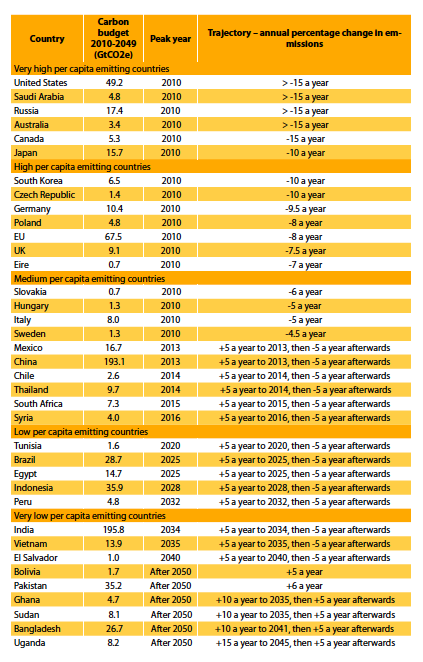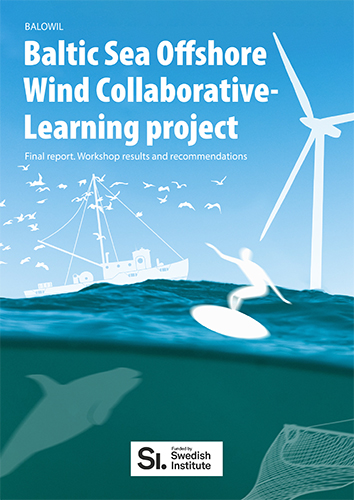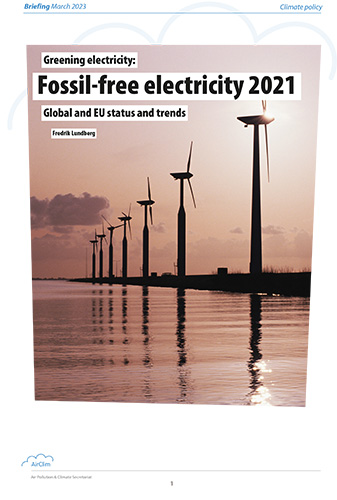
The remaining carbon budget
Between 750 Gt and 1000 Gt of global CO2 emissions is all that remains if the world is to have a 75 per cent chance of staying below the 2°C target, according to three reports.
In the Cancun agreements reached last December the United Nations adopted for the first time a target that global average temperature increase due to global warming should stay below 2°C compared with pre-industrial levels. It was also decided in Cancun that the UN should now analyse a 1.5°C target and the paths required to reach it. The next IPCC 5th Assessment Report, to be published in 2013/2014, will include a 1.5°C scenario.
Governments now have to decide how to stay below the 2°C ceiling, and over the next few months the European Union, for example, will adopt a roadmap and emission reduction goals for 2020 to 2050. There is a clear risk that those decisions will not correspond with what science tells us is needed to reach the targets with high probability.
Several scientific institutions and environmental organisation have recently conducted research to calculate how much carbon dioxide, or greenhouse gases as a whole, can be emitted globally while still having a chance of staying below the 2-degree target. The German Advisory Council on Global Change (WBGU)1 calculation for the global CO2 budget is described in the following paragraphs.
“In order to limit global warming to 2°C, a cap must be set on the total amount of CO2 emitted globally from fossil-fuel sources. Due to their sheer quantity and immense longevity in the atmosphere, CO2 emissions must be the key focus of climate change mitigation. WBGU therefore proposes the introduction of a mandatory global cap in the form of a global CO2 budget that may be emitted until the year 2050. The higher the desired probability of limiting warming to 2°C, the smaller the available budget is to be set.
WBGU proposes a global budget of 750 Gt CO2 for the period 2010–2050. With this amount, there is a two-thirds probability that climate warming can be kept within the 2°C guard rail.
A world population of 6.9 billion in the year 2010 and a global budget of 750 Gt CO2, would allow for average annual per-capita emissions of 2.7 t CO2 until 2050. National emissions budgets are based on the size of the national population. With an estimated population of 82.2 million for 2010, Germany would have a national CO2 budget of 9 Gt. How quickly a country exhausts its national budget will depend on its emissions and hence its mitigation efforts. If Germany’s annual CO2 emissions of around 0.9 Gt remain unchanged at the current level and no flexible mechanisms are deployed, the German budget would be exhausted within 10 years.”2
Ecofys, the Dutch research institute, estimates the maximum level of greenhouse gas emissions necessary to achieve the 2°C target depending on the probability of meeting this target. It was estimated that in order to have a 50 per cent chance of meeting the 2°C target, CO2 emissions should total no more than 2,000 Gt between the years 2000 and 2050. Increasing the probability of meeting such a target to 75 per cent would mean that a maximum of 1,500 Gt can be allowed within this period. Between 2000 and 2010, global emissions already account for roughly 500 Gt of CO2. This implies that between 2010 and 2050, a maximum of 1,000–1,500 Gt can be emitted in order to meet the 2°C target with probabilities of 75 per cent and 50 per cent, respectively.3
In the United Kingdom, Friends of the Earth with advice from the Tyndall Centre for Climate Change Research has calculated the remaining global carbon budget as well. Their global carbon budget of 1,100 Gt CO2 equivalents would require a very steep and unprecedented decline in global emissions.4
The report says that if the maximum amount of global emissions the world could allow were shared out equally on the basis of average populations between now and 2050, the US would need to reduce its emissions by as much as 95 per cent by 2030, the EU by 83 per cent, and the UK by 80 per cent. China would need to peak its emissions by 2013 and then reduce them by five per cent per year. The report shows emissions reductions for individual countries based upon an equal sharing of 1,100 Gt CO2 equivalents 2010-2049 global budget (Table 1).
If historical, cumulative emissions are counted, the US and EU have already used more than their share of the global carbon budget. Emissions in these countries would need to cease immediately.
Reinhold Pape

Table1 shows emissions reductions for individual countries based upon an equal sharing of 1,100 Gt CO2 equivalents 2010-2049 global budget, assuming no negative emissions.
1 The German Advisory Council on Global Change (WBGU) was established by the German Federal Government as an independent, scientific advisory body in 1992 in the run-up to the Rio Earth Summit. WBGU is an interdisciplinary body which provides in-depth scientific analyses and derives recommendations for policy action and research.
2 German Advisory Council on Global Change (WBGU), 2009, Solving the climate dilemma: The budget approach, Special Report and Factsheet
3 “Emission pathways towards 2ºC”, Utrecht: EcoFys, 2009 , EcoFys, 2009, N. Hohne, C. Ellerman, R. de Vos
4 Reckless Gamblers – How Politicians’ inaction is ramping up the risk of dangerous climate change, Friends of the Earth England, Wales and Northern Ireland, 2010,

 Download this issue
Download this issue Between 750 Gt and 1000 Gt of global CO2 emissions is all that remains if the world is to have a 75 per cent chance of staying below the 2°C target, according to three reports.
Between 750 Gt and 1000 Gt of global CO2 emissions is all that remains if the world is to have a 75 per cent chance of staying below the 2°C target, according to three reports.










